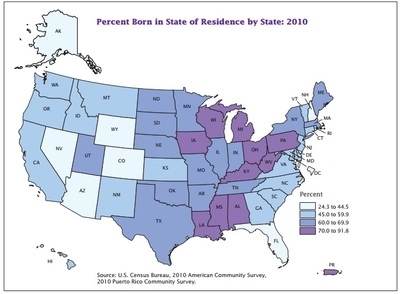With change comes conflict. That's life. The "life" of a city is no different. But no change brings conflict too. Just ask the Rust Belt.
Community conflict often arises with migration, particularly with an influx of newcomers. Wariness toward the outsider is as old as time. The nomadic gypsy has been cast into the communal underground. "Okie get out" was a common refrain in 1940s California. More recently, migratory Buckeyes have drawn the local's ire.
"Ohioans have invaded the Lowcountry...and some folks wish they would leave," reads the title of a 2010 piece in the Charleston City Paper.
Today, San Francisco is the flash point for such community conflict. The growth of the tech sector has brought a swarm of geek types to the Bay, igniting a culture clash between the San Francisco of activism and bohemianism against the digerati lifestyle that is permeating from the start-up culture of Silicon Valley.
"We're becoming akin to a mining boomtown," writer Rebecca Solnit laments in a recent Guernica piece called "Resisting Monoculture": "A place overwhelmed by an influx of mostly young, mostly male people from elsewhere who are not committed to this place and don't know it well and are transforming its culture to suit themselves."
Of course, such issues are not confined to San Francisco but exist all over. Over in Brooklyn, one former resident can't keep up:
This city is changing too much. It's always changing, here and there, but now it's too much, too fast. I come back to Brooklyn...and I get off the train, and everything is different. Everything! Usually, one thing or another is different, but now? My eyes, my brain...
Often, the term "gentrification" colors much of this conflict. But more centrally, the issue is about the "right" to space. It is a right that gets its legitimacy from the belief that the best communities are the most "rooted" communities. Here, the "self" is deep-seated in a landscape called "home".
Yet this right of localization is increasingly being rubbed the wrong way by the reality of globalization. For instance, the migration of newcomers has raised an "existential issue" among the English, with former British Ambassador Charles Crawford openly wondering if the country is "entitled" to maintain its identity.
Crawford references Japan as one culture determined to maintaining a static sense of "Japaneseness." The country is crafting policy to deal with its aging population and declining demographic base through its "energetic work with robots" so it doesn't have to import "large numbers of foreigners whose presence will undermine Japan's highly specific cultural integrity."
Intense. But are such measures worth it? Or is there a more optimal give and take in which some uprooting is needed, if not ultimately beneficial?
When it comes to the Rust Belt we would have to say so.
For instance, Ohio and Michigan rank in the bottom three nationwide when it comes to birthplace diversity, along with Louisiana. More exactly, nearly 75 percent of Michigan and Ohio folks live in the state where they were born, compared to 54 percent for California. As you can see from the Census map below, much of the Rust Belt suffers from a kind of migratory sclerosis via a lack of newcomers.
Why is this a problem?
With migration comes a deepening of a city's idea bank and an enrichment of its global connectivity. With migration comes growth. Absent a flow of people, metros struggle to find their footing in the information age. Without migration, cities "shrink," not only demographically but economically.
Reads a recent National Bureau of Economic Research paper called "Birthplace Diversity and Economic Prosperity":
We show that birthplace diversity...is positively related to economic development even after controlling for education, institutions, ethnic and linguistic fractionalization, trade openness, geography, market size and origin-effects.
You could say, then, that the Rust Belt has a bit of an identity crisis as well. But it's a conflict of irrelevancy that comes with being unwanted, as opposed to San Francisco's plight of being wanted too much.
Regardless, the challenge for all cites is the same: finding a balance between knowing who you were, who you are, and who you can no longer be. The city, like the self, is constantly evolving, and the "right" to the city moves with it. The key is to find a sweet spot between too much circulation and too little. Or between the chains of nostalgia and the void of having no sense of place.
To that end, maybe Slate writer Matt Yglesias was on to something when he wrote the piece "Move Silicon Valley to Cleveland".
Don't laugh. CNN Money recently voted Cleveland as "the next Brooklyn". Oh, and the second largest net population growth feeder into Cleveland according to the U.S. Census?
Brooklyn, naturally.
Perhaps rust doesn't sleep after all.


